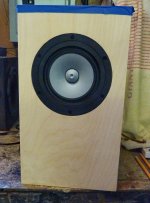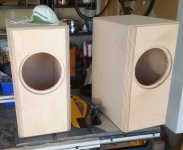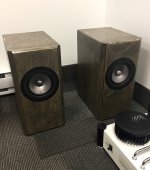On one level I would like to simply build what I think is probably the best stand mount box available for the MA10P drivers that are on their way to me, the Wooden Design Simple Reflex 0V9. Over the past couple of years I have watched several of Scott Lindgrens videos on box design and am tremendously impressed with the depth of knowledge he brings to getting the best out of the MA drivers. But, I would very much like to have the speakers be significantly smaller than his 17.6L design.
The speakers will be located in a 15X15 foot room with a 9' ceiling and 6'X7' open pocket doors into the adjacent 15'X15' room. Because of a fierplace with a large hearth in one corner of the room and a large L shaped sofa, the speakers need to be placed about 6 feet apart on each side of the hearth and 8 feet from the listening position. They can only be placed about 18inches from the front and side walls. I am currently using Thiel 2.4 speakers with Conrad Johnson solid state electronics and the speakers tend to be bass heavy and overwhelm the room.
I listen mostly to jazz, classical, and folk music; very little rock or bass heavy material, except for some electronic and new age music.
I want to try some quality full range speakers and have built many 2 way and a few extended range speakers using mostly Tang Band 4 inch "full range " drivers. An audiophile friend has assured me that the MA Alpair 10Ps are substantially better than the Tang Bands (which are very nice in some ways but lack the detail and sparkle of a good 2 way).
So I have purchased a pair of 10Ps and am going to build the cabinets for them, but really want something smaller than Scott's design if possible. I have modeled the 10P in WinIsd at 13 L and it suggests that I would lose about 5Hz bass extention. However , having watched Scott's videos, I think there would be other, perhaps very significant, losses in performance because of the numerous design features of his Simple Reflex 0V9.
The obvious answer as to what to do is, "Just build Scott's design", but aesthetics are important and I would really like a speaker that is no more than about 8.5" wide X 14 tall and 11"deep.
So, If you Mark Audio afficianados can suggest a proven 13L or smaller cabinet for my drivers I would greatly appreciate your input.
Best,
Jay
The speakers will be located in a 15X15 foot room with a 9' ceiling and 6'X7' open pocket doors into the adjacent 15'X15' room. Because of a fierplace with a large hearth in one corner of the room and a large L shaped sofa, the speakers need to be placed about 6 feet apart on each side of the hearth and 8 feet from the listening position. They can only be placed about 18inches from the front and side walls. I am currently using Thiel 2.4 speakers with Conrad Johnson solid state electronics and the speakers tend to be bass heavy and overwhelm the room.
I listen mostly to jazz, classical, and folk music; very little rock or bass heavy material, except for some electronic and new age music.
I want to try some quality full range speakers and have built many 2 way and a few extended range speakers using mostly Tang Band 4 inch "full range " drivers. An audiophile friend has assured me that the MA Alpair 10Ps are substantially better than the Tang Bands (which are very nice in some ways but lack the detail and sparkle of a good 2 way).
So I have purchased a pair of 10Ps and am going to build the cabinets for them, but really want something smaller than Scott's design if possible. I have modeled the 10P in WinIsd at 13 L and it suggests that I would lose about 5Hz bass extention. However , having watched Scott's videos, I think there would be other, perhaps very significant, losses in performance because of the numerous design features of his Simple Reflex 0V9.
The obvious answer as to what to do is, "Just build Scott's design", but aesthetics are important and I would really like a speaker that is no more than about 8.5" wide X 14 tall and 11"deep.
So, If you Mark Audio afficianados can suggest a proven 13L or smaller cabinet for my drivers I would greatly appreciate your input.
Best,
Jay
You won't necessarily have a significant drop in performance; depends what you define as such anyway. My own designs are what they are & those are simply the set of compromises I chose for a given enclosure. I don't pretend they are above criticism, let alone the last word. Besides, it doesn't matter how good (or otherwise) a given design is if you can't use it.
Assuming the CJ amplifiers have a reasonably low output impedance and factoring in 0.5ohm for wire loop, connection resistance, 13 litres (actual, once driver, vent & bracing volumes are accounted for) to about 45Hz should give a nicely damped response character. It doesn't have as much usable extension as a larger box, but that's the sacrifice. It may sound a little more compressed; I would be inclined to have the vent on the rear panel to reduce the chance of any audible noise through excess velocity at higher levels. Since it's a reasonably well-damped alignment it shouldn't cause any issues with excess room coupling.
Assuming the CJ amplifiers have a reasonably low output impedance and factoring in 0.5ohm for wire loop, connection resistance, 13 litres (actual, once driver, vent & bracing volumes are accounted for) to about 45Hz should give a nicely damped response character. It doesn't have as much usable extension as a larger box, but that's the sacrifice. It may sound a little more compressed; I would be inclined to have the vent on the rear panel to reduce the chance of any audible noise through excess velocity at higher levels. Since it's a reasonably well-damped alignment it shouldn't cause any issues with excess room coupling.
The optimum Mar-Ken for the 10p is, like Scott’s, 17litres. Their is also a 13 litre one with a small reduction in bass extension, and (if i have not already drawn it, done modeling for a 10 litre version.
The free CGR (Classic Golden Ratio) variation is 13 litres.
dave
The free CGR (Classic Golden Ratio) variation is 13 litres.
dave
Member
Joined 2009
Paid Member
I have built the 17lite box myself and found that it works really well indeed. I too was worried about the size of the box so I made it narrower whilst keeping to the 17l design total volume. It's an oft used visible trick. Nevertheless, if I was that bothered about the size I wouldn't hesitate to cut the box volume down to 13 lites and still with an expectation of acceptable results. I have the metal cone driver but I may eventually try the paper version, which only requires a change to the vent length (i.e. easy for me because of how I designed the vent). I placed the vent on the rear of the box, also for aesthetic reasons (a position approved by Scott in one of his posts somewhere). The joints are mitred and later the external edges bevelled as I like the appearance. Finished in ‘grey’ Danish Oil which actually has a green tinge so I call these speakers “Nori”.
Attachments
Last edited:
Many,many thanks gents. Since the consensus is that there not big penalty associated with cabinet designs somewhat smaller than 17.6L, I have been playing around with WinIsd to come up with something that should sound good. The first design I did was before my post here and was a box 14T X 8.5 W X 10.5 D for a gross Vb of 12.5L The tuning frequency which gave the "best" F3 was 60Hz, which resulted in an F3 of 61, an F6 of 53 and an F10 of 48. The modeled results showed this tuning to be flat to 80Hz with the steep rolloff as seen in the figures above.
Remembering Scott's discussions of the benefits of considering room gain in the design, I used WinIsd to investigate the tuning of his 17.6L design. WinIsd suggested that his tuning frequency was 47Hz. Returning to my original design, I increased the box volume very slightly to 13.6L gross and set the tuning frequency to 47Hz. This resulted in a 2" port 6.8" long instead of the original 3.9". Quite a difference! This alignment results in an F3 of 70Hz an F6 of 50 and an F10 of 41. This alignment has the more gradual roll off that Scott recommends, being -1db@ 125Hz -2db @85 and -3 @70. This is less than the room gain he discusses in his video, but the concept he discusses is shown in the simulation.
I like front ported designs and with the lower bass output and maximum SPL I'm thinking that the maximum modeled port velocity of 16.5 Cm/sec won't be audible.
So, where I am now is planning on building a front ported box, 14"T X 8.5" W X 11" D with a 2" X 6.8" port. Material will be 1/2" Baltic birch with a single traverse cross brace slightly off center between the side panels.
Feedback regarding this plan would be greatly appreciated.
Thanks again All,
Jay
Remembering Scott's discussions of the benefits of considering room gain in the design, I used WinIsd to investigate the tuning of his 17.6L design. WinIsd suggested that his tuning frequency was 47Hz. Returning to my original design, I increased the box volume very slightly to 13.6L gross and set the tuning frequency to 47Hz. This resulted in a 2" port 6.8" long instead of the original 3.9". Quite a difference! This alignment results in an F3 of 70Hz an F6 of 50 and an F10 of 41. This alignment has the more gradual roll off that Scott recommends, being -1db@ 125Hz -2db @85 and -3 @70. This is less than the room gain he discusses in his video, but the concept he discusses is shown in the simulation.
I like front ported designs and with the lower bass output and maximum SPL I'm thinking that the maximum modeled port velocity of 16.5 Cm/sec won't be audible.
So, where I am now is planning on building a front ported box, 14"T X 8.5" W X 11" D with a 2" X 6.8" port. Material will be 1/2" Baltic birch with a single traverse cross brace slightly off center between the side panels.
Feedback regarding this plan would be greatly appreciated.
Thanks again All,
Jay
Room gain varies from situation to situation, so I'd be a little careful assuming too much, although it sounds like you're on the right lines given the stated requirements. FWIW, I don't personally recommend a regular duct of that length though as the self-harmonics may start to become more apparent (my own ROT is a maximum 6in axial length for a regular duct, and preferably no more than 5in if possible. These are guidelines only of course, and ultimately it's a balancing act of air velocity against self-harmonics).
I'd still suggest you consider moving the vent to the rear panel. With that kind of alignment, you're not likely to have significant issues with excess coupling to a given mode & it should reduce the audibility of any duct resonances in the same way it helps reduce the audibility of excess air velocity. YMMV as always of course. Since I'm a dinosaur, I tend to prefer slightly thicker panels, so if you can kick that up to 3/4in, I'd be inclined to do so, which will also make flush mounting the driver and relieving the cutout internally somewhat easier.
I'd still suggest you consider moving the vent to the rear panel. With that kind of alignment, you're not likely to have significant issues with excess coupling to a given mode & it should reduce the audibility of any duct resonances in the same way it helps reduce the audibility of excess air velocity. YMMV as always of course. Since I'm a dinosaur, I tend to prefer slightly thicker panels, so if you can kick that up to 3/4in, I'd be inclined to do so, which will also make flush mounting the driver and relieving the cutout internally somewhat easier.
Last edited:
...an F3 of 70Hz an F6 of 50 and an F10 of 41.
Worth keepin gin mind that F3/F6/F10 hilites the roll-off, to the human ear/brain F3 is meaningless, and that F6/F10 are the much more useful numbers.
... a single traverse cross brace slightly off center between the side panels.
it is not clear what direction you intend to put the brace but:
1/ The aspect ratio (ratio of the lengths of the sides) of the subpanel created by the brace should be higher than the aspect ratio of the panel being braced (ref Tappan)
2/ a brace parallel to the baffle should not be placed right behind the driver
dave
The 10P likes a bit larger boxes i see when i'm modelling. I come to the same results more or less as Planet 10. With the 10M you can go smaller and a 13L could do 50Hz in ported cabinet, but the 10P needs more. 13 will only give you 60Hz.
Hi Guys, the speakers are built, have about 40 hours on them and sound very nice. They have good detail, harmonic richness, tonality, imaging and dynamic range. The bass seems a bit light, but since I'm limiting them to 80 db max at this point it is hard to judge that aspect. My issue is, as good as they are, I don't know if they could sound even better. At this point the tops are simply taped (and weighted) in place so some changes can easily be made.
Specifically, the actual build has 15 net liters, construction is of 3/4 inch baltic birch, all interior surfaces lined with 3/8 inch jute automotive headliner and the port is 2 inches in diameter by 4.5 inches long, for a tuning frequency of 51Hz.
So, what, if any, noticably audible changes might I hear if I changed the port length to 6.25 inches to get to Scott's suggested 45Hz tuning frequency? Also, would adding another 3/8 inch layer of jute to some or all of the interior surfaces be worthwhile?
I strongly suspect that any audible changes from doing either of these would be minimal and, again, I am very pleased with them as they are now, but before I glue the tops on I am hoping to get input from folks who have actual experience with similar designs.
Thanks!
Jay
Specifically, the actual build has 15 net liters, construction is of 3/4 inch baltic birch, all interior surfaces lined with 3/8 inch jute automotive headliner and the port is 2 inches in diameter by 4.5 inches long, for a tuning frequency of 51Hz.
So, what, if any, noticably audible changes might I hear if I changed the port length to 6.25 inches to get to Scott's suggested 45Hz tuning frequency? Also, would adding another 3/8 inch layer of jute to some or all of the interior surfaces be worthwhile?
I strongly suspect that any audible changes from doing either of these would be minimal and, again, I am very pleased with them as they are now, but before I glue the tops on I am hoping to get input from folks who have actual experience with similar designs.
Thanks!
Jay



Here is proof. The shot with the motorcycle batteries on top is how I've been listening. I took them off for the shot which captures the magnificient feng shui of my workshop more fully. They are all mitered and the joints came out reasonably clean, so I will probably just finish them in clear shellac after I glue the tops on. I'm still hoping to get input regarding fine tuning before the final gluing and finishing though.
FWIW, Hornresp, a known accurate program, calculates a 52.4 Hz Fb for 15 L/2" dia. x 4.5" L vent, making it ever so slightly under-damped whereas 45 Hz = 6.3" L/16 cm with a slightly over-damped response, ~1 Hz lower F10, i.e. unless room interaction significantly modifies this ~50-200 Hz BW, doubtful anyone would notice the difference and with the higher tuning you can always critically damp* the vent in room, which is a better overall choice since you get the optimum in room transient response with a shorter vent, i.e. a variation of Dave's resistive vents without the extra woodworking.
* Click Test | GM210 | Flickr
GM
* Click Test | GM210 | Flickr
GM
- Home
- Loudspeakers
- Full Range
- Help with box design for MA Alpair 10P, please.


